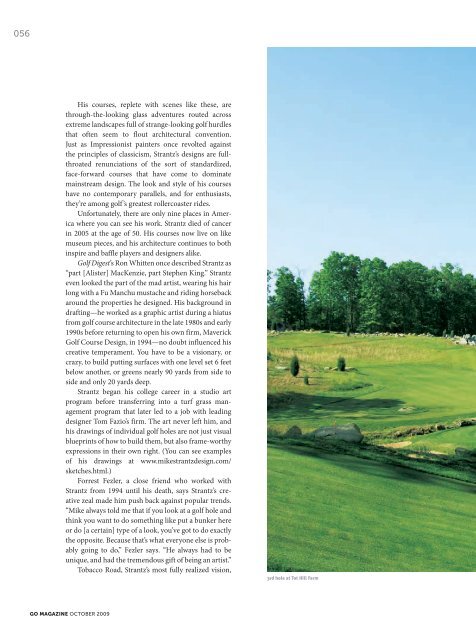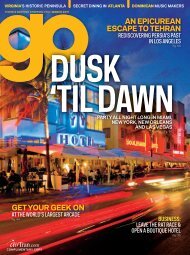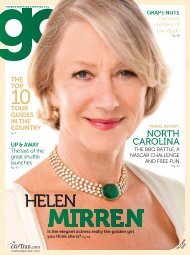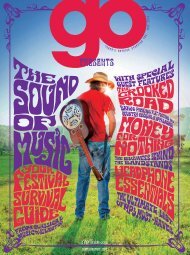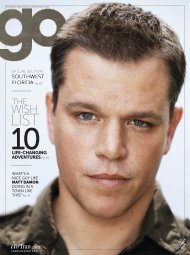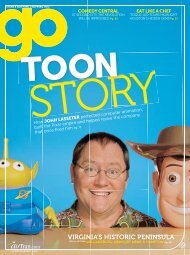Create successful ePaper yourself
Turn your PDF publications into a flip-book with our unique Google optimized e-Paper software.
056<br />
His courses, replete with scenes like these, are<br />
through-the-looking glass adventures routed across<br />
extreme landscapes full of strange-looking golf hurdles<br />
that often seem to flout architectural convention.<br />
Just as Impressionist painters once revolted against<br />
the principles of classicism, Strantz’s designs are fullthroated<br />
renunciations of the sort of standardized,<br />
face-forward courses that have come to dominate<br />
mainstream design. The look and style of his courses<br />
have no contemporary parallels, and for enthusiasts,<br />
they’re among golf ’s greatest rollercoaster rides.<br />
Unfortunately, there are only nine places in America<br />
where you can see his work. Strantz died of cancer<br />
in 2005 at the age of 50. His courses now live on like<br />
museum pieces, and his architecture continues to both<br />
inspire and baffle players and designers alike.<br />
Golf Digest’s Ron Whitten once described Strantz as<br />
“part [Alister] MacKenzie, part Stephen King.” Strantz<br />
even looked the part of the mad artist, wearing his hair<br />
long with a Fu Manchu mustache and riding horseback<br />
around the properties he designed. His background in<br />
drafting—he worked as a graphic artist during a hiatus<br />
from golf course architecture in the late 1980s and early<br />
1990s before returning to open his own firm, Maverick<br />
Golf Course Design, in 1994—no doubt influenced his<br />
creative temperament. You have to be a visionary, or<br />
crazy, to build putting surfaces with one level set 6 feet<br />
below another, or greens nearly 90 yards from side to<br />
side and only 20 yards deep.<br />
Strantz began his college career in a studio art<br />
program before transferring into a turf grass management<br />
program that later led to a job with leading<br />
designer Tom Fazio’s firm. The art never left him, and<br />
his drawings of individual golf holes are not just visual<br />
blueprints of how to build them, but also frame-worthy<br />
expressions in their own right. (You can see examples<br />
of his drawings at www.mikestrantzdesign.com/<br />
sketches.html.)<br />
Forrest Fezler, a close friend who worked with<br />
Strantz from 1994 until his death, says Strantz’s creative<br />
zeal made him push back against popular trends.<br />
“Mike always told me that if you look at a golf hole and<br />
think you want to do something like put a bunker here<br />
or do [a certain] type of a look, you’ve got to do exactly<br />
the opposite. Because that’s what everyone else is probably<br />
going to do,” Fezler says. “He always had to be<br />
unique, and had the tremendous gift of being an artist.”<br />
Tobacco Road, Strantz’s most fully realized vision,<br />
GO MAGAZINE OCTOBER <strong>2009</strong><br />
3rd hole at Tot Hill Farm


